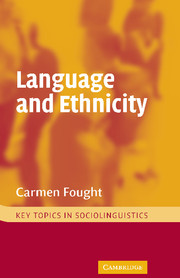Book contents
- Frontmatter
- Contents
- Preface
- Acknowledgments
- Part I General issues in ethnicity and language
- Part II Linguistic features and ethnicity in specific groups
- Part III The role of language use in ethnicity
- 8 Discourse features, pragmatics, and ethnicity
- 9 Interethnic communication and language prejudice
- 10 Crossing: may I borrow your ethnicity?
- Notes
- Glossary of terms
- References
- Index
- References
10 - Crossing: may I borrow your ethnicity?
Published online by Cambridge University Press: 05 September 2012
- Frontmatter
- Contents
- Preface
- Acknowledgments
- Part I General issues in ethnicity and language
- Part II Linguistic features and ethnicity in specific groups
- Part III The role of language use in ethnicity
- 8 Discourse features, pragmatics, and ethnicity
- 9 Interethnic communication and language prejudice
- 10 Crossing: may I borrow your ethnicity?
- Notes
- Glossary of terms
- References
- Index
- References
Summary
They should stick to their own culture and not try to impersonate no one else.
(15-year-old black adolescent boy in South London, from Hewitt 1986:161)The term “crossing” (also called “language crossing” or “code-crossing”) comes from the work of Ben Rampton (1995, 1999) in Britain, and can be defined as “the use of language varieties associated with social or ethnic groups that the speaker does not normally ‘belong’ to” (1995:14). Rampton's work follows in the path of some similar work by Hewitt (1982, 1986), also in Britain. We know from a large body of sociolinguistic research that people generally speak like the people they want to be like. Despite a widely held belief that the omnipresent availability of television is leveling out dialect differences, linguists have shown that this is not the case. If we live in Alabama, we don't suddenly begin to talk like a newscaster from Chicago, because for the most part we want to sound like those around us, our peers, the members of the communities of practice (see Eckert and McConnell-Ginet 1992) with which we identify. In a sense, this entire book up to this point has been an illustration of how that process works.
- Type
- Chapter
- Information
- Language and Ethnicity , pp. 197 - 215Publisher: Cambridge University PressPrint publication year: 2006



